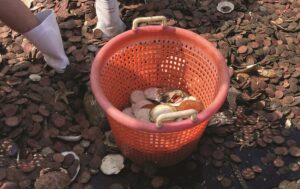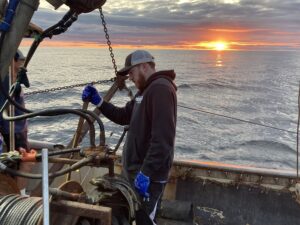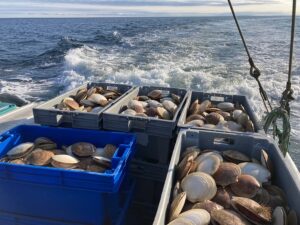PROVINCETOWN — There is no doubt that scalloping brings in dollars — sand dollars, at least.
Falling from the dredge like poker chips in a casino advertisement, they clink against each other as they form mini-mountains on the boat’s deck. Crabs skitter over them and over a few incidentally landed groundfish, while the boat’s crew digs through to pull out white, omega-shaped shells.

After the scallops have been tossed into buckets and the fish hurled back overboard, the crew grab their shovels and turn their attention to the reddish-brown, slimy coins piled up to their ankles.
“We call them cookies,” said Josh Howe of Chatham, as he shoveled sand dollars over the side of the F/V Roen Keil, as if he were clearing a walkway after a snowstorm. “They’re so annoying.”
As for bringing in the other kind of dollars, that’s a job that Wellfleet fisherman Damien Parkington says is not so easy, at least for small-boat fishermen. Low wholesale prices for scallops, a spike in the cost of gas, and, perhaps more than anything else, a quota system that makes fishing for scallops expensive are all part of the story.
“You have to buy your boat, outfit your boat, and then you have to buy that permit, and then you have to buy or lease quota,” said Parkington, owner of the Roen Keil. There is much debt to be repaid before you can make a profit, he said.
Howe and Ben Parkington, Damian’s cousin, who was captaining the boat, performed the same shoveling task 19 times over the course of a 17-hour trip off the coast of Provincetown on June 19, one for each tow of the dredge. Howe said shoveling is his least favorite part of the job — it hurts his back.
But scooping sand dollars is just one aspect of a small-boat scalloper’s routine, a 30-minute cycle that is repeated again and again over the course of trips that often last more than 15 hours.
Josh and Ben, each wearing fishing boots and a baseball cap, had arrived at MacMillan Pier in a pickup truck at 2 am. Parkington sported a mustache and black hair that flowed out the back of his hat down to his thrift-store fraternity sweatshirt. He had opted for shorts despite the chill of the night air and ocean breeze, while Howe, who had a carefully groomed red beard that matched his hair, wore athletic pants with a large gray stripe down the side.
After a brisk trek over the boardwalk, the two stepped onto the 40-foot Roen Keil. The boat, which is no thing of beauty, Howe noted, has an open deck with rusted sides and a matrix of metal cranes, chains, and ropes extending upward over a small control area. A cramped space below deck features a wide cushioned ledge scattered with boxes of soda cans and jugs of water — and the constant growl of the boat’s engine.

Hanging from a crane on the deck was the vessel’s crown jewel: a net of rope and circular metal links crossed with chains and attached to a triangle with bars in the middle: the dredge.
It wouldn’t see action for a few hours, while Parkington motored to the target area nine miles north of Provincetown. When they arrived before sunrise, with the sky the same dark blue as the ocean, Howe, who had been sleeping below deck, got up and joined Parkington — it was time to unleash the dredge.
Manning a series of levers near a giant spool of metal rope, Parkington sunk the net into the water and, with the boat again cruising forward, he let the rope unspool as the dredge dragged behind the boat. It scraped the ocean floor for 30 minutes before Parkington began to pull it in.
With another push of a lever, the rope came hurtling backward, making an angry buzz as it wrapped around the spool. Howe grabbed a long metal pole and alternatively pulled and pushed against the incoming rope to prevent it from tangling. The sun was just peeking over the horizon.
Once the top of the dredge breached the water, Parkington and Howe used the crane to pull it up. The sagging metal net emerged carrying an unwieldy gift basket from the bottom of the ocean. Sea water streamed from the bottom, sand dollars and shells fell through and crashed onto the boat, skate wriggled limply, and the dredge itself twisted and turned with Parkington and Howe working to pull it back onto the boat. Finally, they attached the crane to the bottom of the dredge, dumping the chaotic package onto the deck.
Then, as Parkington went to put the dredge back in the water and restart the process, Howe began picking scallops from the pile.
Most of the time, scallops are shucked on the boat. But on this trip, Parkington and Howe had a special order from their wholesaler, Wellfleet Shellfish Company, for large live scallops. Those they tossed into large bins, which were occasionally sprayed with water. They tossed the smaller ones into a bucket. Later that morning, they would get to work on shucking.
Scallopers are competitive about who can shuck the fastest, Howe said, and he’s slow in comparison with the best. But standing at the side of the boat with a scallop in his left hand and a knife in his right, Howe stuck the blade between the shells and, in one motion, popped the top off and over the side with all of the bivalve’s organs attached, leaving behind just the white pillow of meat against the bottom half of the shell. Then, he coolly scraped the meat into a water-filled bucket with the side of his knife and tossed the bottom shell into the sea. The whole process took a couple of seconds. Then he grabbed another scallop.

Howe and Parkington performed the same routine 19 times over the course of the morning and afternoon, slowly filling the bins of live scallops and the buckets of shucked scallops. They hit their target of 1,500 pounds of live scallops by about 5 p.m.
They set their course back to shore, but the work wasn’t over. They still had a boat to clean.
Rogue sea dollars that had evaded their shovels occupied every corner of the Roen Keil and were beginning to “ooze green,” as Howe put it, leaving behind a dirty slime. They stuck the boat’s hose into every nook, flooding the deck with gallons of sea water and sweeping the sand dollars back where they came from.
By the time the boat returned to the pier at 7 p.m., the Wellfleet Shellfish Company truck was waiting at a loading station on the 20-foot-high dock. Howe climbed up the ladder and took charge of the remote-controlled crane. He lowered it down to Parkington, who had tied ropes around the bins. Parkington hooked them to the crane before Howe lifted it back up, the payload twisting in the air.
Back on the deck, in the space vacated by the bins, were a few more brown coins. Parkington took a look and kicked them into the sea.
This is the first installment of a series of articles on the small-boat fishing fleet of the Outer Cape.
